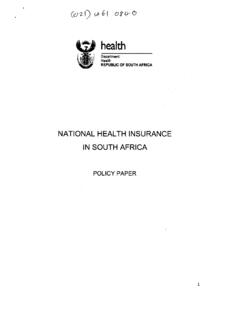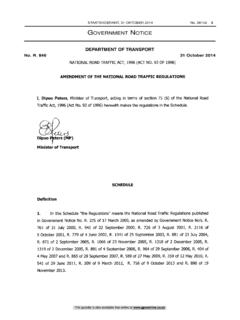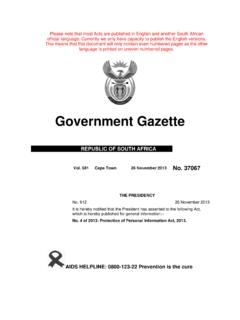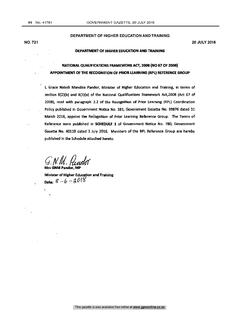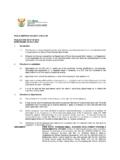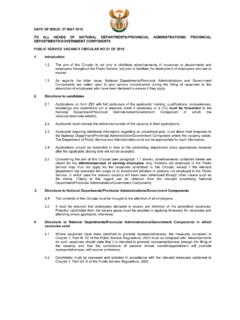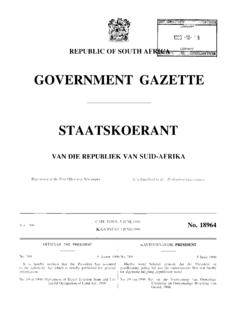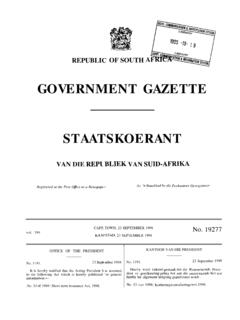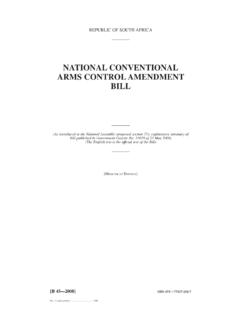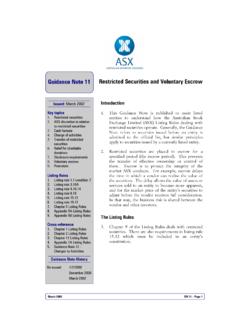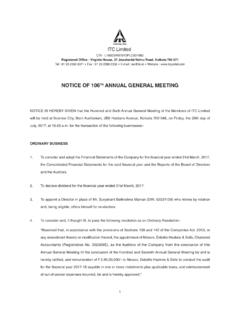Transcription of Guidelines for the provision of boarding facilities in ...
1 Guidelines for the provision of boarding facilities in public ordinary schoolsGuidelines for the provision of boarding facilities in public ordinary schoolsGuidelines for the provision of boarding facilities in public ordinary schools2 Guidelines for the provision of boarding facilities in public ordinary schools3 Table of ContentsACRONYMS AND for providing boarding of the Guidelines for the provision of boarding facilities underpinning the and applications of the of the and responsibilities of the Department of Basic Education (DBE) and the Provincial Education Departments (PEDs) of a boarding facility facility criteria for subsidy/Bursary transport for Guidelines for boarding facilities of boarding of boarding establishment for a boarding and responsibilities of staff and boarding fees for of boarding facilities28 Guidelines for the provision of boarding facilities in public ordinary schools4 ACRONYMS AND AbbreviationsAIDSA cquired Immune Deficiency SyndromeDBED epartment of Basic EducationCCTVC losed circuit televisionDVDD igital video discGPSG lobal Positioning SystemHIVH uman Immunodeficiency VirusHVACH eating.
2 Ventilation and air conditioningMECsMembers of the Executive CouncilNEPAN ational Education policy ActNNSSFN ational Norms and Standards for School FundingNBRN ational Building RegulationsNCNP costNon-capital non-personnel cost N & SNorms and StandardsPAMP ersonnel Administration Measures PSCBCP ublic Service Co-ordinating Bargaining Council PEDsProvincial education departmentsSABSS outh African Bureau of StandardsSASAS outh African Schools ActSGBsSchool governing bodiesTVTelevisionWSAW ater Services ActGuidelines for the provision of boarding facilities in public ordinary schools51. Introduction The former Department of Education developed the National policy for an Equitable provision of an Enabling School Physical Teaching and Learning Environment. The purpose of this policy is to provide strategic direction in the equitable provisioning of school infrastructure, including boarding facilities , with the aim of improving access to quality education.
3 The development of the Guidelines for the provision of boarding facilities follows the approval of the National policy for an Equitable Provisioning of an Enabling School Physical Teaching and Learning Environment. Lack of access to schools by learners, more especially in rural areas, was identified as one of the challenges that impacted on the provision of quality education and learner achievement. This resulted in learners from rural and farm areas leaving school before the end of the compulsory phase of education; absenteeism; and late arrival at schools due to the distances they have to travel to and from school. In addressing these challenges, learner transport or boarding facilities are provided as an alternative to improving learners access to Some of the key challenges relating to the provision and management of boarding facilities relate to a lack of funding for boarding facilities ; sufficient space to accommodate all needy learners; health, safety and environmental issues surrounding boarding facilities ; and the management and maintenance of these Rationale for providing boarding Access to education: boarding facilities provide access to education for learners from remote rural areas and farming communities.
4 boarding facilities also provide learners with exposure to the world beyond the confines of their community. They provide a solution for learners living in areas where the state cannot provide schools, thus eliminating the difficulties of transport across significant distances, including cost, the dangers involved in it and the time being consumed. boarding facilities also allow access to a choice of education (type and quality), and access to further education for learners whose local schools are limited to the lower Curricular and language needs: boarding facilities allow learners to pursue particular specialised curricular directions (such as technical and agricultural fields), not necessarily available to them at their local schools. Integrated hostels encourage language and cultural tolerance and Academic and other forms of supervision: The advantages of academic supervision and of a disciplined environment constitute an important reason for providing boarding facilities .
5 The benefits of such an environment for learners from, for example single-working-parent families, families in which the parents are compelled to travel extensively, or families which are unable to provide after-school supervision for learners. boarding facilities create the space, time and conditions that are conducive to studying. Learners in boarding facilities have increased contact time with educators, academic support and are offered extra classes. Improved living conditions and opportunities: boarding facilities provide learners with increased opportunities, facilities and resources. boarding facilities also provide many disadvantaged learners with an opportunity to enjoy better living conditions (and sometimes better care) than they would experience in their home environments and that the relatively inexpensive living costs, as well as bursaries and subsidies awarded to some learners, make this possible.
6 Access to basic amenities, such as electricity and shelter, as well as to more sophisticated facilities , such as television, computers and media centres in some schools, Guidelines for the provision of boarding facilities in public ordinary schools6facilitates some of the benefits gained by learners in these facilities . Related to the issue of improved living conditions, is that boarding facilities provide better nutrition than some learners might receive at Extra-curricular activities: By staying in boarding facilities , learners are able to participate in extra-curricular activities, including sport and cultural activities. Learners therefore receive a more holistic education as a result of living in these Safety, stability and care: boarding facilities provide a relatively safe environment for children (and many of whom are at risk) living in informal settlements and townships and/or being without supervision for much of the day.
7 They also provide a stable environment for children from broken homes or families with social problems, as well as to children whose home environments are less than stable. This could include orphans, including HIV/AIDS Personal development: boarding facilities also facilitate positive social development and the ability to accept others from different social or cultural backgrounds. The boarding facilities environment inculcates independence, self-discipline and the ability to work as part of a team in learners. Cost: provision of boarding facilities can be a cost-efficient measure in small, sparsely populated rural and farming communities. The cost of running small schools can be minimised by accommodating learners in a central place of learning. In most cases, the schools in these areas have low enrolment figures and sometimes there are multi-graded classrooms that make teaching and learning difficult.
8 Small schools and non-viable schools could be merged to reduce the running and maintenance costs of Learner pass rate: Better living conditions, which boarding facilities provide to disadvantaged learners or learners from rural areas, who have to travel long distances to school, provide learners with conditions that are conducive to learning and, resultantly, they facilitate an improved pass Learner drop-out rate: Learners who have to travel long distances to school and back home are exposed to all kinds of challenges, like arriving late for school, being absent from school or being tired due to the long hours they have to spend on the road. Accommodation of learners in boarding facilities will eradicate all these challenges and reduce the drop-out rate at Objectives of the Guidelines for the provision of boarding facilities The main objective of the Guidelines is to provide guidance in the provision of boarding facilities to learners for whom education is, or may become inaccessible in the future, and also to allow the authorities to adopt a more uniform approach on the management of boarding facilities at schools.
9 The detailed objectives of the Guidelines are provide guidance with regard to the equitable provision and management of boarding facilities at schools; provide a systematic and strategic prioritisation of needs regarding the core elements of an enabling environment for boarding facilities at schools; enable provincial education departments (PEDs) to effectively control and manage the cost of such provision and to facilitate efficient use of resources in the boarding facilities ; Guidelines for the provision of boarding facilities in public ordinary enable PEDs to regulate the provision of infrastructure in boarding facilities ; and implement Guidelines for the monitoring and evaluation of boarding facilities operations. 4. Principles underpinning the The principles underpinning the Guidelines emanate from the National policy on an Equitable Provisioning of an Enabling School Physical Teaching and Learning Environment.
10 They are the canons of the national and sector policies, namely: Broad-based access Equity and redress Quality and effectiveness Functional relevance Efficiency National values as explained in the Legal The Constitution of the Republic of South Africa, 1996 (Act No. 108 of 1996). The National Education policy Act, 1996 (Act No. 27 of 1996). The South African Schools Act, 1996 (Act No. 84 of 1996). South African Bureau of Standards: National Building Regulations and Water Services Act, 1997 (Act No. 108 of 1997).6. Scope and applications of the The Guidelines will apply to all public schools with boarding facilities in South Africa and the Members of Executive Council (MECs) will ensure that all schools with boarding facilities conform to the Guidelines as indicated in this document. The Guidelines do not apply to boarding facilities at Special Schools.
